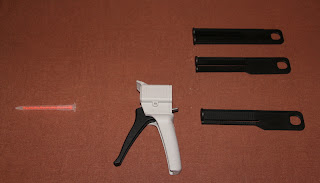 |
| Pelican 1750 with mounted plate |
This was a project for my dad. It is a
Pelican 1750 case which has attached to it an aluminum plate water
jet cut with his initials. Attaching the plate to the case was a bit
more challenging than expected, and by 'a bit' I mean I spent almost
2 months worrying over it before I was willing to attempt it.
These Pelican cases are made of
polypropylene a plastic which has, among its many properties, a low
surface energy. Simply put it is hard to get things to stick to it.
In the past I tried a 2 part epoxy,
which sticks to most things, on one of these cases and it did not
adhere. Not only did it not adhere the cured resin detached from the
case with almost no effort. It detached so easy I could have used the
epoxy to make a mold of the case.
Eventually I checked the FAQ on the
Pelican website (probably should have done this first) which
recommended using 3M Scotch-Weld DP 8005. This product is somewhat
pricy. I spent, before shipping, a bit more than $1/mL for this
stuff. This turned out to be the least of my issues as the cartridge
for the Scotch-Weld requires a special gun to apply which is sold
separately.
 |
| Dispenser for Scotch-Weld Adhesives |
But the gun is just the beginning of
your woes. While the gun comes with two plungers (the upper black
rods in the photo) neither of them works with the 8005 cartridge. A
10:1 plunger is required (the bottom rod) which also had to be
ordered separately. In addition to the gun and the plunger you also
need mixing tubes (the clear and red cylinders in the photo). This is
the most vexing part. I assumed since the mixing tubes and cartridges
are used in a 1:1 ratio and cannot be reused the mixing tube would
come with the cartridge. Nope. They are sold separately as well.
Maximum vexation achieved.
Mercifully after the scavenger hunt to
get the parts it turned out to be easy to use with the only catch
being the 8005 has a working time of only 3 minutes. The work area
was protected with standard masking tape, the part to be attached was
checked and aligned, the adhesive was laid down and then the part was
placed and weight applied. It is necessary to support the lid from
underneath. When pressure is applied to the plate the force
distribution causes the case lid to bow underneath it. This would
increase the gap underneath the middle of the plate if the underside
of the case lid was not supported.
In the end it worked out well and the
adhesive turns out to be rather strong. Hopefully I will have another
project for which this 8005 will be necessary. I certainly spent
enough on its accouterments so it would be nice to get more than one
use from them.

No comments:
Post a Comment